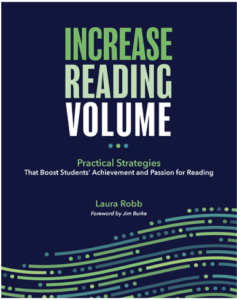Boost Students’ Skills and Passion for Reading
Increase Reading Volume: Practical Strategies That Boost Students’ Achievement and Passion for Reading
By Laura Robb
(NCTE, 2022 – Learn more)
Reviewed by Sarah Valter

Experienced ELA educator Laura Robb tackles this issue head-on in her newest professional book, Increase Reading Volume: Practical Strategies That Boost Students’ Achievement and Passion for Reading.
For intermediate, middle, and high school teachers who already build choice and independence into the reading block, this book will affirm and extend your practices. For those who are just beginning to tentatively explore a reading block that creates agency and expands the limits of what students can do, everything you need to both get started and continue growing can be found within this text.

In a time when students are reading less than ever, educators have a responsibility to immerse kids in reading within the classroom setting. This work begins with engagement, and Robb establishes a philosophy of teaching rooted in engagement from the first chapter.
By explaining several concrete aspects of reading engagement, she makes it clear that engagement is the path to volume. And it is not only students who need to read with engagement and volume; Robb gently nudges practicing teachers to build out our own reading lives and to lead by example.
While this is a text about increasing the amount our students read, Robb emphasizes that quantity will grow as the quality of student work also grows. Readers must engage with books in multiple ways: a variety of reading experiences, reflection, discussion, and writing.
Reading is an act of building relationships with others and finding relevance in the text. Robb’s work shows teachers exactly how to bring these goals to fruition through independent reading, partnerships and small groups, instructional reading unit libraries, and core collections.
Independent Reading
In framing the work that teachers do with students, Robb writes, “Choosing a book and reading has to be [their] decision” (p. 34). In other words, our role as educators is to set the stage and cultivate reading, often a task that requires a significant amount of patience and time.
When discussing the merits of independent reading, Robb focuses not only on the why and the how, but also provides the what: detailed guidance for book talks, tips for book reviews, and explicit directives for activities that “need to go” in favor of more authentic practices.
Partnerships and Small-Group Collaborations
As students develop independent reading habits, it becomes essential to also engage them in reading partnerships and small group work. Robb lays out the framework for four types of small groups: book clubs, teacher-led discussions, readers’ theater, and student-led literary conversations.
Each has unique merits, and it is critical to involve students in the process of decision-making as these models are slowly rolled out within an ELA classroom. She includes structures to guide teachers in practices from setting up group work to assessment.
Instructional Reading Unit Libraries
Beyond the work students typically do in an ELA classroom, there are countless opportunities to grow students’ understanding of genres and themes. By building instructional reading unit libraries – large sets of books centered around a specific genre or theme with a high-quality anchor text for use by the teacher – students will apply both independent reading and small group/partnership work to the exploration of books at an even deeper level.
This work is rich in opportunities for students to grow skills by reading deeply and widely, and its natural tie-ins to writing about reading are emphasized by Robb’s suggestions for notebook entries, a list of “dos and don’ts,” and guidance for when and how to model these skills for students.
Core Collections
The final segment of Increase Reading Volume focuses on building “core collections” – sets of contemporary titles which align with the more traditional classics that are often the backbone of secondary ELA courses. This chapter is centered around the why (to broaden students’ views of reading and the world around them) and abundant in the how with prompts for discussing related texts, suggestions for writing about reading, assessment guidance, and ideas for engaging in this work with colleagues.
Final Thoughts
Although Laura Robb aims her messaging at grades 4-12, as a teacher with an elementary background who has used a fair number of these approaches in my own classroom, I walked away from this text with new ideas, new resources, and a new outlook on some old practices.
Robb provides readers with a clear rationale for increasing volume through agency and supports this work with a wealth of ideas and resources. From sample interest inventories and unit plans to exemplar resources and observation forms, this text is packed with ideas that will affirm your existing practices, push your thinking, and get you excited about the reading lives of every single student in your classroom.
Sarah Valter is the district Literacy Coordinator for Lindbergh Schools in St. Louis, MO. In her two decades in education, Sarah has taught in the primary and intermediate grades, mentored new teachers, coached at the building and district levels, and led professional development in literacy.
Sarah is also an adjunct instructor at St. Louis University and has recently been added as a co-author for the Two Writing Teachers. She believes strongly that all children and adults should not only have the skills to read and write, but also the motivation to live as lifelong readers and writers.




































